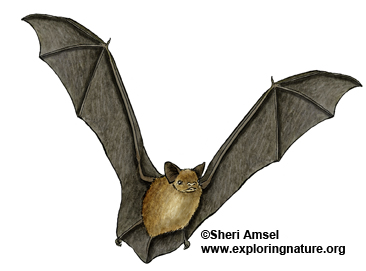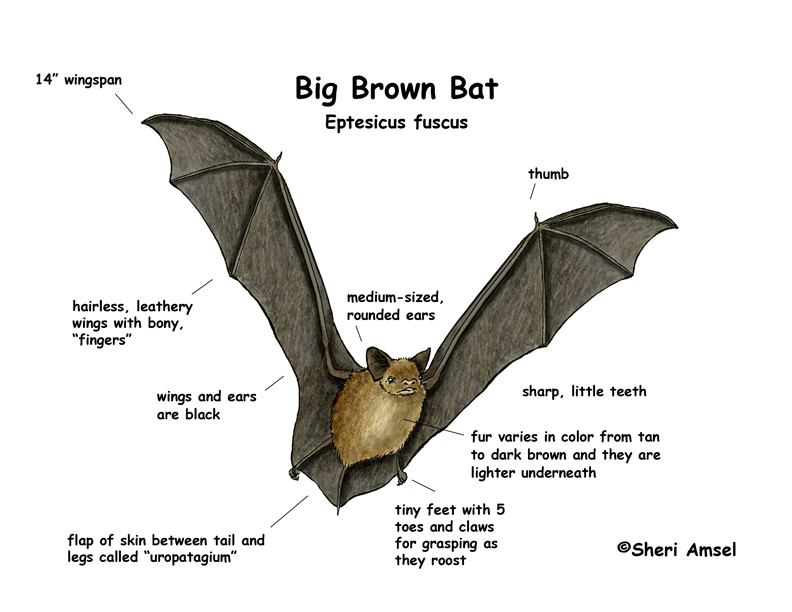

They are found from southern Canada, throughout the U.S. and south through South America.
They live in the forest, but have become used to living in towns and cities and towns. They roost in attics, barns, under the eaves of porches and in rocky cracks. They hibernate in caves, mines and other safe places that don’t get too cold in winter.
This is a large bat (compared to most of the U.S. bats) that can reach more than 5 “ (long though almost half of this is tail) and it still weighs less than an ounce! They have a 14” wingspan and have medium-sized, rounded ears and sharp, little teeth. Their fur varies in color from tan to dark brown and they are lighter underneath. Their wings and ears are black. There is a flap of skin that stretched between the legs and tail called the uropatagium.
They are nocturnal, hunting at night by using echolocation. Echolocation is a kind of radar that uses the bat’s high-pitched calls to bounce off objects. They can actually “see” what is around them by how their calls bounce off their surroundings. They tend to live in big groups and several can be seen fling and swooping after insects in one area.
They eat insects. They prefer beetle but will eat any flying insect.
They are killed by birds of prey like owls and hawks, and when roosting are taken by raccoons, weasels and even house cats.
They mate in the fall before they start hibernating, but females store the sperm until spring when they become pregnant for about 2 months (gestation). They give birth to 1-2 pups and nurse them for up a month when they begin to fly and can survive on their own. Breeding females form large colonies of hundreds of bats. The mothers leave their babies to hunt for food each night. A nursing female uses a lot of energy feeding their babies and must eat almost their own body weight in insects every night. They can locate their own young among the hundreds of babies left in the roost when they return from feeding.
They can live up to 20 years in the wild.
Related Resources:
High Resolution Diagram
Kingdom: Animalia
Phylum: Chordata
Subphylum: Vertebrata
Class: Mammalia
Order: Chiroptera
Family: Vespertilionidae
Subfamily: Vespertilioninae
Genus: Eptesicus
Species: Eptesicus fuscus
When you research information you must cite the reference. Citing for websites is different from citing from books, magazines and periodicals. The style of citing shown here is from the MLA Style Citations (Modern Language Association).
When citing a WEBSITE the general format is as follows.
Author Last Name, First Name(s). "Title: Subtitle of Part of Web Page, if appropriate." Title: Subtitle: Section of Page if appropriate. Sponsoring/Publishing Agency, If Given. Additional significant descriptive information. Date of Electronic Publication or other Date, such as Last Updated. Day Month Year of access < URL >.
Amsel, Sheri. "Bat (Big Brown) " Exploring Nature Educational Resource ©2005-2024. December 15, 2024
< http://exploringnature.org/db/view/467 >

